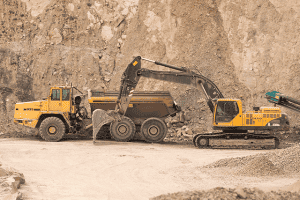Workplace safety on construction sites is a critical concern for both employers and employees. It is not just about protecting people; it’s about creating a productive, efficient, and responsible culture. Unfortunately, in Australia, the statistics on work-related accidents are startling.
In 2022, a shocking 160 Australians lost their lives due to work-related accidents, and a significant portion of these fatalities were the result of vehicle-related collisions involving cars, trucks, tractors, and other vehicles. This information comes from Safe Work Australia and paints a distressing picture of the state of workplace safety in the country. (Source: Safe Work Australia).
But the fatalities are only part of the story. In addition to the lives lost, there were over 130,000 serious accident claims lodged in the same year. These accidents, while not fatal, had a significant impact on the lives of the workers involved, with an average of 7 weeks in time lost per claim. The economic, emotional, and physical toll on the individuals and their families is immeasurable.
We need to understand what is causing these accidents. Are they a result of insufficient safety measures, lack of training, or something else? In the case of vehicle-related accidents, what can be done to ensure that those who operate vehicles as part of their job are doing so safely?
The numbers are clear: work-related accidents in Australia are a significant issue, costing lives and impacting the well-being of workers. It is imperative that this issue is tackled with a multi-faceted approach involving individuals, employers, and government bodies. By promoting safety, education, and responsibility, we can work towards reducing these troubling statistics and creating a safer working environment for all Australians.
Construction Site Risks
A typical Australian construction site presents risks like these to its’ workforce every day, with heavy mobile machinery like pickers and forklifts regularly operating in the same space as workers.
It goes without saying that the safe transfer and movement of items on-site has to be the upmost priority. Introducing new safety initiatives or additional safety training can help lower these on-site risks, but still the danger is a real one. Load-shifting equipment (powered mobile plant such as trucks, cranes, bobcats, forklifts, pallet jacks) all present real safety risks to pedestrians such as:
Collisions:
Load-shifting equipment, including trucks, cranes, bobcats, forklifts, pallet jacks, and other powered mobile plants, pose a significant safety risk to pedestrians due to the potential for collisions. These machines are often large, heavy, and may have limited maneuverability, making it difficult for operators to quickly respond to unexpected movements of pedestrians. In busy construction sites or warehouses, where there are numerous workers and pedestrians moving around, the risk of collisions increases. A momentary lapse in attention or a miscommunication can lead to a collision, resulting in severe injuries or even fatalities.
Falling objects:
Load-shifting equipment is designed to transport heavy loads, which can include construction materials, equipment, or other items. If these loads are not properly secured or positioned, there is a risk of them falling off the equipment and causing harm to pedestrians nearby. Even a small object falling from height can cause serious injuries. Moreover, when cranes or other lifting equipment are used, there is a risk of unintended swinging or dropping of loads, potentially hitting pedestrians who are unaware of the hazard.
Limited visibility:
Load-shifting equipment, such as trucks, forklifts, or bobcats, often have blind spots or restricted visibility for operators. Pedestrians can inadvertently enter these blind spots, making them vulnerable to accidents. The size and design of the equipment can obstruct the operator’s view of their surroundings, including pedestrians and other potential hazards. In such situations, the operators heavily rely on their training, experience, and caution to mitigate the risks. However, there is always the possibility of a pedestrian being in the wrong place at the wrong time, which can lead to accidents.
To address these safety risks, it is crucial to implement comprehensive safety measures. These measures may include:
1. Training and awareness: Providing thorough safety training to all personnel, including equipment operators and pedestrians, regarding the potential risks and safety protocols is essential. Pedestrians should be educated on how to navigate around load-shifting equipment and understand the associated hazards.
2. Traffic management: Implementing effective traffic management plans, including clearly marked pedestrian walkways and designated areas for equipment operation, can help reduce the likelihood of collisions. Establishing communication protocols and using visible warning signs or signals can also enhance safety.
3. Maintenance and inspections: Regular maintenance and inspections of load-shifting equipment are crucial to ensure their proper functioning. Any defects or issues should be promptly addressed to minimize risks.
4. Use of safety devices: Installing safety devices like cameras, alarms, proximity sensors, and reflective markings on load-shifting equipment can improve visibility for operators and pedestrians. These devices can help operators identify the presence of pedestrians and take appropriate actions to prevent accidents.
5. Supervision and accountability: Maintaining active supervision and holding individuals accountable for following safety procedures is vital. Regular monitoring of operations and addressing any deviations from safety protocols can help create a culture of safety and encourage responsible behavior.
In summary, the safe transfer, movement, and placement of items on-site should be a top priority. Load-shifting equipment poses real safety risks to pedestrians, including collisions, falling objects, and limited visibility. By introducing new safety initiatives, providing training, implementing traffic management plans, conducting regular maintenance, using safety devices, and ensuring supervision and accountability, the risks associated with load-shifting equipment can be mitigated, creating a safer working environment for everyone involved.
Taking into account the danger these hazards pose to workers and your sites productivity every day, are these risks you can afford any longer?
How Construction Site Managers Mitigate Risk
The most common response to these risk factors is to take the site layout into account and putting physical barriers in place, separating pedestrians from vehicles, plus introducing control measures such as:
– Minimising the cross flow of traffic, intersections and eliminating blind spots.
– Clearly defining and positioning parking areas so they can be accessed without crossing driveways or loading dock vehicle paths.
– Clearly marking pedestrian walkways or using temporary physical barriers to separate pedestrians from roadways and powered mobile plant operating areas where pedestrians and vehicles often interact based on speed limits, stopping distances and efficient workflow.
– Defining areas where powered mobile plant is used as ‘pedestrian exclusion zones’ and excluding powered mobile plant from pedestrian walkways and work areas.constructio
– Using line markings and marker posts in docking areas to indicate distances from the dock.
However, introducing these changes to your construction site still may not be enough…
Construction-Site Risk: The Human Factor
Initiatives such as line markings, barriers and verbal/ written notices to stay a certain distance clear of vehicles are only effective so long as your staff and site visitors understand these directions and stick to them. Human error and negligence are always at play, on top of the legal obligations to uphold worker safety.
With risks like these ever-present, could your construction site use BodyGuard Pedestan Warning System.
